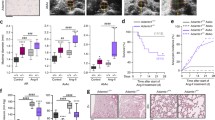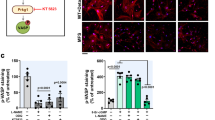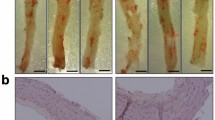Summary
Objective: Fabry disease results from α-gala- ctosidase A deficiency and is characterized by the lysosomal accumulation of globotriaosylceramide. Globotriaosylceramide storage predominantly affects endothelial cells, altering vascular wall morphology and vasomotor function. Our objective was to investigate aortic globotriaosylceramide levels, morphology and function in a mouse model of Fabry disease, and the effect of substrate reduction therapy, using the glycosphingolipid biosynthesis inhibitor N-butyldeoxynojirimycin. Methods and results: Mice used were C57BL/6J and α-galactosidase A knockout (Fabry). We show progressive accumulation of aortic globotriaosylceramide throughout the lifespan of untreated Fabry mice (55-fold elevation at 2 months increasing to 187-fold by 19 months), localized to endothelial and vascular smooth-muscle cells; there was no effect on vascular wall morphology in young Fabry mice. In old mice, storage resulted in intimal thickening. Endothelial function declined with age in Fabry mouse aorta. Aortae from N-butyldeoxynojirimycin-treated Fabry mice at 19 months of age had reduced endothelial globotriaosylceramide storage, fewer morphological abnormalities and less severe vasomotor dysfunction compared with untreated littermates. Conclusion: We provide evidence of a novel vascular phenotype in the Fabry mouse that has relevance to vascular disease in Fabry patients. N-Butyldeoxynojirimycin treatment partially prevented the phenotype in the Fabry mouse by reducing endothelial globotriaosylceramide storage.
Similar content being viewed by others
Abbreviations
- ACh:
-
acetylcholine
- ERT:
-
enzyme replacement therapy
- D-t-EtDO-P4:
-
D-threo-1-ethylenedioxyphenyl-2-palmitoylamino-3-pyrrolidino-propanol
- Gb3 :
-
globotriaosylceramide
- GSL:
-
glycosphingolipid
- iNOS:
-
inducible nitric oxide synthase
- NB-DNJ:
-
N-butyldeoxynojirimycin
- NO:
-
nitric oxide
- PE:
-
phenylephrine
- SNP:
-
sodium nitroprusside
- SRT:
-
substrate reduction therapy
- VSM:
-
vascular smooth muscle
References
Abe A, Gregory S, Lee L, et al (2000) Reduction of globotriaosylceramide in Fabry disease mice by substrate deprivation. J Clin Invest 105: 1563–1571.
Altarescu G, Moore D, Pursley R, et al (2001) Enhanced endothelium-dependent vasodilation in Fabry disease. Stroke 32: 1559–1562.
Barngrover D (2002) Fabrazyme—recombinant protein treatment for Fabry's disease. J Biotechnol 95: 280–282.
Bodary PF, Shen Y, Vargas FB, et al (2005) Alpha-galactosidase A deficiency accelerates atherosclerosis in mice with apolipoprotein E deficiency. Circulation 111: 629–632.
Boutouyrie P, Laurent S, Laloux B, et al (2001) Non-invasive evaluation of arterial involvement in patients affected with Fabry disease. J Med Genet 38: 629–631.
Brady RO (2006) Enzyme replacement for lysosomal diseases. Annu Rev Med 57: 283–296.
Brady RO, Murray G, Moore D, et al (2001) Enzyme replacement therapy in Fabry disease. J Inherit Metab Dis 24: 18–24; discussion 11–12.
Chruscinski A, Brede ME, Meinel L, et al (2001) Differential distribution of beta adrenergic receptor subtypes in blood vessels of knockout mice lacking beta 1- or beta 2-adrenergic receptors. Mol Pharmacol 60: 955–962.
Cooke J, Andon N, Girerd X, et al (1991) Arginine restores cholinergic relaxation of hypercholesterolemic rabbit thoracic aorta. Circulation 83: 1057–1062.
Cox TM, Lachmann R, Hollak C, et al (2000) Novel oral treatment of Gaucher's disease with N-butyldeoxynojirimycin (OGT 918) to decrease substrate biosynthesis. Lancet 355: 1481–1485.
DeGraba T, Azhar S, Dignat-George F, et al (2000) Profile of endothelial and leukocyte activation in Fabry patients. Ann Neurol 47: 229–233.
Demuth K, Germain DP (2002) Endothelial markers and homocysteine in patients with classic Fabry disease. Acta Paediatr Suppl 91: 57–61.
Desnick R, Ioannou Y, Eng C (2001).α-Galactosidase A deficiency: Fabry disease. In: Scriver CR, Beaudet AL, Sly WS, Valle D, eds; Childs B, Kinzler KW, Vogelstein B, assoc, eds. The Metabolic and Molecular Bases of Inherited Disease, 8th edn. New York: McGraw-Hill, 3733–3774.
Eitzman DT, Bodary PF, Shen Y, et al (2003) Fabry disease in mice is associated with age-dependent susceptibility to vascular thrombosis. J Am Soc Nephrol 14: 298–302.
Garner B, Priestman DA, Stocker R, et al (2002) Increased glycosphingolipid levels in serum and aortae of apolipoprotein E gene knockout mice. J Lipid Res 43: 205–214.
Gilligan D, Guetta V, Panza J, et al (1994) Selective loss of microvascular endothelial function in human hypercholesterolemia. Circulation 90: 35–41.
Groves P, Kurz S, Just H, et al (1995) Role of endogenous bradykinin in human coronary vasomotor control. Circulation 92: 3424–3430.
Guzik TJ, Mussa S, Gastaldi D, et al (2002) Mechanisms of increased vascular superoxide production in human diabetes mellitus: role of NAD(P)H oxidase and endothelial nitric oxide synthase. Circulation 105: 1656–1662.
Itoh Y, Esaki T, Cook M, et al (2001) Local and global cerebral blood flow and glucose utilization in the alpha-galactosidase A knockout mouse model of Fabry disease. J Neurochem 79: 1217–1224.
Jeyakumar M, Butters TD, Borja MC, et al (1999) Delayed symptom onset and increased life expectancy in Sandhoff disease mice treated with N-butyldeoxynojirimycin. Proc Natl Acad Sci USA 96: 6388–6393.
Mitsias P, Levine S (1996) Cerebrovascular complications of Fabry's disease. Ann Neurol 40: 8–17.
Moore D, Scott L, Gladwin M, et al (2001) Regional cerebral hyperperfusion and nitric oxide pathway dysregulation in Fabry disease: reversal by enzyme replacement therapy. Circulation 104: 1506–1512.
Moore D, Altarescu G, Pursley R, et al (2002) Arterial wall properties and Womersley flow in Fabry disease. BMC Cardiovasc Disord 2: 1.
Ohshima T, Murray G, Swaim W, et al (1997) Alpha-galactosidase A deficient mice: a model of Fabry disease. Proc Natl Acad Sci USA 94: 2540–2544.
Ohshima T, Schiffmann R, Murray G, et al (1999) Aging accentuates and bone marrow transplantation ameliorates metabolic defects in Fabry disease mice. Proc Natl Acad Sci USA 96: 6423–6427.
Pieper G, Peltier B (1995) Amelioration by l-arginine of a dysfunctional arginine/nitric oxide pathway in diabetic endothelium. J Cardiovasc Pharmacol 25: 397–403.
Pieper G, Siebeneich W, Moore-Hilton G, et al (1997) Reversal by l-arginine of a dysfunctional arginine/nitric oxide pathway in the endothelium of the genetic diabetic BB rat. Diabetologia 40: 910–915.
Platt FM, Neises GR, Dwek RA, et al (1994) N-Butyldeoxynojirimycin is a novel inhibitor of glycolipid biosynthesis. J Biol Chem 269: 8362–8365.
Platt FM, Neises G, Reinkensmeier G, et al (1997a) Prevention of lysosomal storage in Tay–Sachs mice treated with N-butyldeoxynojirimycin. Science 276: 428–431.
Platt FM, Reinkensmeier G, Dwek RA, et al (1997b) Extensive glycosphingolipid depletion in the liver and lymphoid organs of mice treated with N-butyldeoxynojirimycin. J Biol Chem 272: 19365–19372.
Prasad A, Husain S, Schenke W, et al (2000) Contribution of bradykinin receptor dysfunction to abnormal coronary vasomotion in humans. J Am Coll Cardiol 36: 1467–1473.
Stroes E, Kastelein J, Cosentino F, et al (1997) Tetrahydrobiopterin restores endothelial function in hypercholesterolemia. J Clin Invest 99: 41–46.
Wing D, Garner B, Hunnam V, et al (2001) High-performance liquid chromatography analysis of ganglioside carbohydrates at the picomole level after ceramide glycanase digestion and fluorescent labeling with 2-aminobenzamide. Anal Biochem 298: 207–217.
Wise D, Wallace H, Jellinck E (1962) Angiokeratoma corporis diffusum: a clinical study of eight affected families. Q J Med 31: 177–206.
Zervas M, Somers K, Thrall M, et al (2001) Critical role for glycosphingolipids in Niemann–Pick disease type C. Curr Biol 11: 1283–1287.
Author information
Authors and Affiliations
Corresponding author
Additional information
Communicating editor: Guy Besley
Competing interests: None declared
Rights and permissions
About this article
Cite this article
Heare, T., Alp, N.J., Priestman, D.A. et al. Severe endothelial dysfunction in the aorta of a mouse model of Fabry disease; partial prevention by N-butyldeoxynojirimycin treatment. J Inherit Metab Dis 30, 79–87 (2007). https://doi.org/10.1007/s10545-006-0473-y
Received:
Revised:
Accepted:
Published:
Issue Date:
DOI: https://doi.org/10.1007/s10545-006-0473-y




